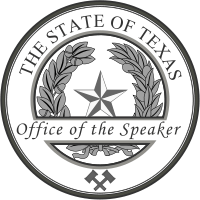Seal of Texas
| Seal of Texas | |
|---|---|
 | |
| Versions | |
|
Reverse | |
| Details | |
| Armiger | State of Texas |
| Adopted | 1845 |
| Motto |
Remember the Alamo Texas One and Indivisible |
| Use |
Obverse: All Government purposes Reverse: Texas Legislative Medal of Honor |
| National Coat of Arms of Texas (1839-1845) | |
|---|---|
 | |
| Versions | |
|
State Coat of Arms of Texas (1992) | |
|
Texas state historical coat of arms (illustrated, 1876) | |
| Details | |
| Armiger | State of Texas |
| Adopted | 1845 (1839)[1] |
The Seal of the State of Texas was adopted through the 1845 Texas Constitution, and was based on the seal of the Republic of Texas, which dates from January 25, 1839.[2]
Design
The official artwork, drawn by Juan Vega of Round Rock, Texas, was adopted in 1992 by Secretary of State John Hannah, Jr. The seal has specified wording on both the obverse and reverse sides.
Seal obverse
The Texas Constitution states, "There shall be a seal of the State, which shall be kept by the Governor and used by him officially. The seal shall have a star of five points, encircled by olive and live oak branches, and the words 'the State of Texas.'"[3]
Seal reverse
The reverse of the seal has a more detailed design and is also defined by law as follows:
[T]he design for the reverse side of the Great Seal of Texas shall consist of a shield, the lower half of which is divided into two parts; on the shield's lower left is a depiction of the cannon of the Battle of Gonzales; on the shield's lower right is a depiction of Vince's Bridge; on the upper half of the shield is a depiction of the Alamo; the shield is circled by live oak and olive branches, and the unfurled flags of the Kingdom of France, the Kingdom of Spain, the United Mexican States, the Republic of Texas, the Confederate States of America, and the United States of America; above the shield is emblazoned the motto, "REMEMBER THE ALAMO", and beneath the shield are the words, "TEXAS ONE AND INDIVISIBLE"; over the entire shield, centered between the flags, is a white five-pointed star.[1]
In rendering, the Confederate States of America flag is the Stars and Bars.[4]
History
The seal of Texas has changed 5 times since independence from Mexico in 1836. The original Great Seal of the Republic was created on December 10, 1836, by the Congress, with a bill providing that "for the future the national seal of this republic shall consist of a single star, with the letters 'Republic of Texas', circular on said seal, which seal shall also be circular". After initial hopes for the quick annexation of Texas into the United States grew dim, the Third Congress modified the seal and created a national arms in 1839. The bill stated, "The national arms of the Republic of Texas be, and the same is hereby declared to be a white star of five points, on an azure ground, encircled by an olive and live oak branches", as well as that "The national great seal of this Republic shall, from and after the passage of this act, bear the arms of this nation..., and the letters 'Republic of Texas'". When Texas joined the Union in 1845, the new state constitution retained the seal, changing only the word "Republic" to "State", and removed the background from the arms. It was not until 1992 that the seal and arms were standardized.
.svg.png) First Great Seal of the Republic, 1836-1839
First Great Seal of the Republic, 1836-1839.svg.png) Second Great Seal of the Republic, 1839-1845
Second Great Seal of the Republic, 1839-1845.png) Seal of the State of Texas (1879)
Seal of the State of Texas (1879).png) Seal of the State of Texas (1909)
Seal of the State of Texas (1909).svg.png)
Government seals of Texas
There are also numerous seals of the different departments of Texas government, including seals for the Governor and Lieutenant-Governor. They are all based upon the state seal of Texas.
 Seal of the Governor of Texas
Seal of the Governor of Texas Seal of the Lieutenant Governor of Texas
Seal of the Lieutenant Governor of Texas Seal of the Senate of Texas
Seal of the Senate of Texas Seal of the Texas House of Representatives
Seal of the Texas House of Representatives Seal of the Speaker of the Texas House of Representatives
Seal of the Speaker of the Texas House of Representatives Seal of the Texas Attorney General
Seal of the Texas Attorney General Seal of the Texas Secretary of State
Seal of the Texas Secretary of State
County symbols
General state law does not require counties to adopt a seal. However, laws do provide seals for the County Commissioners' Court, County Clerk, and other county offices. Until 1975, the Commissioners' Court seal consisted of a star with five points and the words, "Commissioners Court, ---- County, Texas". A Commissioners' Court may now select its own seal design, with the approval of the Texas Secretary of State.
Counties commonly have a seal or symbol to identify the county unofficially. Many have adopted symbols with the lone star and live oak/olive branches in the center. Some counties have maintained "The State of Texas" at the top, while adding the county name below, while others have replaced "The State of Texas" with the county name, with some adding the year of county establishment at the bottom.
A notable exception is Harris County, which instead uses a symbol with the flag of Texas in the center, which is based on the five-pointed star.
 Seal of Galveston County
Seal of Galveston County Seal of Harris County
Seal of Harris County Seal of Kendall County
Seal of Kendall County Seal of Webb County
Seal of Webb County
See also
- Coats of arms of the U.S. states
- Seals of the U.S. states
- State of Texas
- Symbols of the State of Texas
- Flag of Texas
- Seal (emblem)
References
- 1 2 "The Texas State Seal". The Secretary of State. Retrieved 2010-10-08.
- ↑ "Flag and Seal Design by Peter Krag, approved January 25, 1839". Texas State Library & Archives Commission. 2009-03-06. Retrieved 2010-10-08.
- ↑ http://www.statutes.legis.state.tx.us/Docs/CN/htm/CN.4.htm#4.19 Texas Constitution, Article 4, Section 19.
- ↑ http://www.usflag.org/confederate.stars.and.bars.html
External links
- State Seal of Texas Texas Secretary of State website
- Seal of Texas from the Handbook of Texas Online
- Reverse of the Seal Texas Secretary of State website


.jpg)
.svg.png)